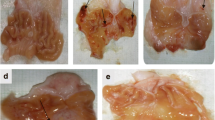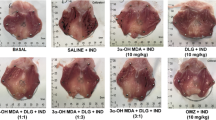Abstract
We revealed a new point with cyclophosphamide (150 mg/kg/day intraperitoneally for 7 days): we counteracted both rat stomach and duodenal ulcers and increased NO- and MDA-levels in these tissues. As a NO-system effect, BPC 157 therapy (10 µg/kg, 10 ng/kg, intraperitoneally once a day or in drinking water, till the sacrifice) attenuated the increased NO- and MDA-levels and nullified, in rats, severe cyclophosphamide-ulcers and even stronger stomach and duodenal lesions after cyclophosphamide + l-NAME (5 mg/kg intraperitoneally once a day). l-arginine (100 mg/kg intraperitoneally once a day not effective alone) led l-NAME-values only to the control values (cyclophosphamide + l-NAME + l-arginine-rats). Briefly, rats were sacrificed at 24 h after last administration on days 1, 2, 3, or 7, and assessment included sum of longest lesions diameters (mm) in the stomach and duodenum, oxidative stress by quantifying thiobarbituric acid reactivity as malondialdehyde equivalents (MDA), NO in stomach and duodenal tissue samples using the Griess reaction. All these parameters were highly exaggerated in rats who underwent cyclophosphamide treatment. We identified high MDA-tissue values, high NO-tissue values, ulcerogenic and beneficial potential in cyclophosphamide-l-NAME-l-arginine-BPC 157 relationships. This suggests that in cyclophosphamide damaged rats, NO excessive release generated by the inducible isozyme, damages the vascular wall and other tissue cells, especially in combination with reactive oxygen intermediates, while failing endothelial production and resulting in further aggravation by l-NAME which was inhibited by l-arginine. Finally, BPC 157, due to its special relations with NO-system, may both lessen increased MDA- and NO-tissues values and counteract effects of both cyclophosphamide and l-NAME on stomach and duodenal lesions.







Similar content being viewed by others
References
Al-Yahya AA, Al-Majed AA, Gado AM, Daba MH, Al-Shabanah OA, Abd-Allah AR (2009) Acacia Senegal gum exudate offers protection against cyclophosphamide-induced urinary bladder cytotoxicity. Oxid Med Cell Longev 2:207–213
Bakan E, Taysi S, Polat MF, Dalga S, Umudum Z, Bakan N, Gumus M (2002) Nitric oxide levels and lipid peroxidation in plasma of patients with gastric cancer. Jpn J Clin Oncol 32:162–166
Barisic I, Balenovic D, Klicek R et al (2013) Mortal hyperkalemia disturbances in rats are NO-system related. The life saving effect of pentadecapeptide BPC 157. Regul Pept 181:50–66
Bedekovic V, Mise S, Anic T et al (2003) Different effect of antiulcer agents on rat cysteamine-induced duodenal ulcer after sialoadenectomy, but not gastrectomy. Eur J Pharmacol 477:73–80
Beevi SS, Rasheed AM, Geetha A (2004) Evaluation of oxidative stress and nitric oxide levels in patients with oral cavity cancer. Jpn J Clin Oncol 34:379–385
Bilic I, Zoricic I, Anic T et al (2001) Haloperidol-stomach lesions attenuation by pentadecapeptide BPC 157, omeprazole, bromocriptine, but not atropine, lansoprazole, pantoprazole, ranitidine, cimetidine and misoprostol in mice. Life Sci 68(16):1905–1912
Blagaic AB, Blagaic V, Romic Z, Sikiric P (2004) The influence of gastric pentadecapeptide BPC 157 on acute and chronic ethanol administration in mice. Eur J Pharmacol 499:285–290
Boban-Blagaic A, Blagaic V, Romic Z et al (2006) The influence of gastric pentadecapeptide BPC 157 on acute and chronic ethanol administration in mice. The effect of N(G)-nitro-l-arginine methyl ester and l-arginine. Med Sci Monit 12:BR36–45
Boddy AV, Yule SM (2000) Metabolism and pharmacokinetics of oxazaphosphorines. Clin Pharmacokinet 38:291–304
Brcic L, Brcic I, Staresinic M, Novinscak T, Sikiric P, Seiwerth S (2009) Modulatory effect of gastric pentadecapeptide BPC 157 on angiogenesis in muscle and tendon healing. J Physiol Pharmacol 60(Suppl 7):191–196
Cesarec V, Becejac T, Misic M et al (2013) Pentadecapeptide BPC 157 and the esophagocutaneous fistula healing therapy. Eur J Pharmacol 701:203–212
Chang CH, Tsai WC, Lin MS, Hsu YH Pang JH (2011) The promoting effect of pentadecapeptide BPC 157 on tendon healing involves tendon outgrowth, cell survival, and cell migration. J Appl Physiol 110:774–780
Chang CH, Tsai WC, Hsu YH, Pang JH (2014) Pentadecapeptide BPC 157 enhances the growth hormone receptor expression in tendon fibroblasts. Molecules 19:19066–19077
Dincer Y, Akcay T, Tortum OB, Dogusoy G (2006) Nitric oxide and antioxidant defense in patients with gastric cancer. Dig Dis Sci 51:1367–1370
Hsieh MJ, Liu HT, Wang CN et al. (2017) Therapeutic potential of pro-angiogenic BPC157 is associated with VEGFR2 activation and up-regulation. J Mol Med (Berl) 95:323–333
Huang T, Zhang K, Sun L et al (2015) Body protective compound-157 enhances alkali-burn wound healing in vivo and promotes proliferation, migration, and angiogenesis in vitro. Drug Des Devel Ther 9:2485–2499
Ilic S, Drmic D, Zarkovic K et al (2010) High hepatotoxic dose of paracetamol produces generalized convulsions and brain damage in rats. A counteraction with the stable gastric pentadecapeptide BPC 157 (PL 14736). J Physiol Pharmacol 61:241–250
Ilic S, Drmic D, Franjic S et al (2011a) Pentadecapeptide BPC 157 and its effects on a NSAID toxicity model: diclofenac-induced gastrointestinal, liver, and encephalopathy lesions. Life Sci 88:535–542
Ilic S, Drmic D, Zarkovic K et al (2011b) Ibuprofen hepatic encephalopathy, hepatomegaly, gastric lesion and gastric pentadecapeptide BPC 157 in rats. Eur J Pharmacol 667:322–329
Kokot A, Zlatar M, Stupnisek M et al (2016) NO system dependence of atropine-induced mydriasis and l-NAME- and l-arginine-induced miosis: reversal by the pentadecapeptide BPC 157 in rats and guinea pigs. Eur J Pharmacol 771:211–219
Mansour HH, El Kiki SM, Hasan HF (2015) Protective effect of N-acetylcysteine on cyclophosphamide-induced cardiotoxicity in rats. Environ Toxicol Pharmacol 40(2):417–422
Marchitti SA, Brocker C, Stagos D, Vasiliou V (2008) Non-P450 aldehyde oxidizing enzymes: the aldehyde dehydrogenase superfamily. Expert opinion on drug metabolism and toxicology 4:697–720
Matthys KE, Bult H (1997) Nitric oxide function in atherosclerosis. Mediators Inflamm 6:3–21
Moncada S, Palmer RMJ, Higgs EA (1991) Nitric oxide: physiology and pharmacology. Pharmacol Rev 43:109–142
Ozawa H, Chancellor MB, Jung SY et al (1999) Effect of intravesical nitric oxide therapy on cyclophosphamide-induced cystitis. J Urol 162:2211–2216
Prkacin I, Separovic J, Aralicia G et al (2001a) Portal hypertension and liver lesions in chronically alcohol drinking rats prevented and reversed by stable gastric pentadecapeptide BPC 157 (PL-10, PLD-116), and propranolol, but not ranitidine. J Physiol Paris 95:315–324
Prkacin I, Aralica G, Perovic D et al (2001b) Chronic cytoprotection: pentadecapeptide BPC 157, ranitidine and propranolol prevent, attenuate and reverse the gastric lesions appearance in chronic alcohol drinking rats. J Physiol Paris 95:295–301
Ribeiro RA, Freitas HC, Campos MC et al (2002) Tumor necrosis factor-alpha and interleukin-1beta mediate the production of nitric oxide involved in the pathogenesis of ifosfamide induced hemorrhagic cystitis in mice. J Urol 167:2229–2234
Sartori S, Trevisani L, Nielsen I, Tassinari D, Panzini I, Abbasciano V (2000) Randomized trial of omeprazole or ranitidine versus placebo in the prevention of chemotherapy-induced gastroduodenal injury. J Clin Oncol 18:463–467
Seiwerth S, Brcic L, Vuletic LB et al (2014) BPC 157 and blood vessels. Curr Pharm Des 20:1121–1125
Seven A, Civelek S, Inci E, Inci F, Korkut N, Burçak G (1999) Evaluation of oxidative stress parameters in blood of patients with laryngeal carcinoma. Clin Biochem 32:369–373
Sikiric P, Seiwerth S, Grabarevic Z et al (1993) Hepatoprotective effect of BPC 157, a 15-amino acid peptide, on liver lesions induced by either restraint stress or bile duct and hepatic artery ligation or CCl4 administration. A comparative study with dopamine agonists and somatostatin. Life Sci 53:PL291–296
Sikiric P, Seiwerth S, Grabarevic Z et al (1994) The beneficial effect of BPC 157, a 15 amino acid peptide BPC fragment, on gastric and duodenal lesions induced by restraint stress, cysteamine and 96% ethanol in rats. A comparative study with H2 receptor antagonists, dopamine promotors and gut peptides. Life Sci 54(5):PL63–68
Sikiric P, Seiwerth S, Grabarevic Z et al (1996a) Beneficial effect of a novel pentadecapeptide BPC 157 on gastric lesions induced by restraint stress, ethanol, indomethacin, and capsaicin neurotoxicity. Dig Dis Sci 41:1604–1614
Sikiric P, Seiwerth S, Grabarevic Z et al (1996b) Salutary and prophylactic effect of pentadecapeptide BPC 157 on acute pancreatitis and concomitant gastroduodenal lesions in rats. Dig Dis Sci 41:1518–1526
Sikiric P, Seiwerth S, Grabarevic Z et al (1997) The influence of a novel pentadecapeptide, BPC 157, on N(G)-nitro-l-arginine methylester and l-arginine effects on stomach mucosa integrity and blood pressure. Eur J Pharmacol 332:23–33
Sikiric P, Seiwerth S, Deskovic S et al (1999a) New model of cytoprotection/adaptive cytoprotection in rats: endogenous small irritants, antiulcer agents and indomethacin. Eur J Pharmacol 364:23–31
Sikiric P, Separovic J, Anic T et al (1999b) The effect of pentadecapeptide BPC 157, H2-blockers, omeprazole and sucralfate on new vessels and new granulation tissue formation. J Physiol Paris 93:479–485
Sikiric P, Seiwerth S, Grabarevic Z et al (2001) Cysteamine-colon and cysteamine-duodenum lesions in rats. Attenuation by gastric pentadecapeptide BPC 157, cimetidine, ranitidine, atropine, omeprazole, sulphasalazine and methylprednisolone. J Physiol Paris 95:261–270
Sikiric P, Seiwerth S, Brcic L et al (2006) Stable gastric pentadecapeptide BPC 157 in trials for inflammatory bowel disease (PL-10, PLD-116, PL 14736, Pliva, Croatia). Full and distended stomach, and vascular response. Inflammopharmacology 14:214–221
Sikiric P, Seiwerth S, Brcic L et al (2010) Revised Robert’s cytoprotection and adaptive cytoprotection and stable gastric pentadecapeptide BPC 157. Possible significance and implications for novel mediator. Curr Pharm Des 16:1224–1234
Sikiric P, Seiwerth S, Rucman R et al (2011) Stable gastric pentadecapeptide BPC 157: novel therapy in gastrointestinal tract. Curr Pharm Des 17:1612–1632
Sikiric P, Seiwerth S, Rucman R et al (2012) Focus on ulcerative colitis: stable gastric pentadecapeptide BPC 157. Curr Med Chem 19:126–132
Sikiric P, Seiwerth S, Rucman R et al (2013) Toxicity by NSAIDs. Counteraction by stable gastric pentadecapeptide BPC 157. Curr Pharm Des 19:76–83
Sikiric P, Seiwerth S, Rucman R et al (2014) Stable gastric pentadecapeptide BPC 157-NO-system relation. Curr Pharm Des 20:1126–1135
Sikirić P, Petek M, Rucman R et al (1993) A new gastric juice peptide, BPC. An overview of the stomach-stress-organoprotection hypothesis and beneficial effects of BPC. J Physiol Paris 87:313–327
Souza-Filho MV, Lima MV, Pompeu MM, Ballejo G, Cunha FQ, Ribeiro RA (1997) Involvement of nitric oxide in the pathogenesis of cyclophosphamide-induced hemorrhagic cystitis. Am J Pathol 150:247–256
Stupnisek M, Franjic S, Drmic D et al (2012) Pentadecapeptide BPC 157 reduces bleeding time and thrombocytopenia after amputation in rats treated with heparin, warfarin or aspirin. Thromb Res 129:652–659
Stupnisek M, Kokot A, Drmic D et al (2015) Pentadecapeptide BPC 157 reduces bleeding and thrombocytopenia after amputation in rats treated with heparin, warfarin, l-NAME and l-arginine. PLoS One 10:e0123454
Taysi S, Uslu C, Akcay F, Sutbeyaz MY (2003) Malondialdehyde and nitric oxide levels in the plasma of patients with advanced laryngeal cancer. Surg Today 33:651–654
Tkalcević VI, Cuzić S, Brajsa K et al (2007) Enhancement by PL 14736 of granulation and collagen organization in healing wounds and the potential role of egr-1 expression. Eur J Pharmacol 570:212–221
Tsakadze NL, Srivastava S, Awe SO, Adeagbo AS, Bhatnagar A, D’Souza SE (2003) Acrolein-induced vasomotor responses of rat aorta. Am J Physiol Heart Circ Physiol 285:H727–H734
Unsal D, Akmansu M, Ozer C, Gonul B, Bora H (2005) Plasma level of lipid peroxidation, total sulphydryl groups and nitric oxide levels in cancer patients irradiated on different anatomic fields: a case-control study. Exp Oncol 27:76–80
Whittle BJR, Boughton-Smith NK, Moncada S (1992) Biosynthesis and role of the endothelium-derived vasodilator, nitric oxide in gastric mucosa. Ann NY Acad Sci 664:126–139
Xu X, Cubeddu LX, Malave A (2001) Expression of inducible nitric oxide synthase in primary culture of rat bladder smooth muscle cells by plasma from cyclophosphamide-treated rats. Eur J Pharmacol 416:1–9
Yousefipour Z, Ranganna K, Newaz MA, Milton SG (2005) Mechanism of acrolein-induced vascular toxicity. J Physiol Pharmacol 56:337–353
Acknowledgements
This research was supported from Ministry of Science, Education and Sports, Republic of Croatia (Grant Number 108-1083570-3635).
Author information
Authors and Affiliations
Corresponding author
Ethics declarations
Conflict of interest
The authors indicated no potential conflicts of interest.
Rights and permissions
About this article
Cite this article
Luetic, K., Sucic, M., Vlainic, J. et al. Cyclophosphamide induced stomach and duodenal lesions as a NO-system disturbance in rats: l-NAME, l-arginine, stable gastric pentadecapeptide BPC 157. Inflammopharmacol 25, 255–264 (2017). https://doi.org/10.1007/s10787-017-0330-7
Received:
Accepted:
Published:
Issue Date:
DOI: https://doi.org/10.1007/s10787-017-0330-7




